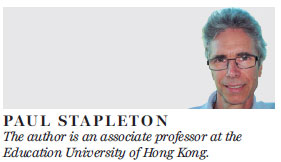Look beyond culling birds to resolve H7N9 crisis
Updated: 2016-06-13 07:14
By Paul Stapleton(HK Edition)
|
|||||||
Once again, chickens have made the headlines for all the wrong reasons. The virus H7N9 was found in a local sample test, sparking the suspension of live poultry trading. The scare has now passed with the culling of "only" 5,600 chickens, and Hong Kong has been spared the anguish of having to eat frozen chicken. This is surely good news for the local population who greatly prefer their dishes prepared from freshly killed chicken over the frozen kind. Not only is this good news for consumers, but also those who raise and sell the birds. Farmers who are prevented from bringing their chickens to market would have had to continue feeding the birds while the suspension was in effect and draw no income. And chicken sellers would have had to resort to selling frozen birds, which are much less profitable. Seldom discussed in this news story, however, are the lives of the chickens. It's almost as if the 5,600 culled birds are a footnote to the story.

The fact is, the short time that these animals spend alive is singularly miserable. And "short" is an overstatement. Broilers, or chickens that are best for human consumption, as opposed to laying eggs, can reach maturity, or in industry parlance, "market weight", in as little as five to six weeks, which is several dozen times shorter than the lifespan they would have in the wild.
Such a short period of time is a reflection of human ingenuity. Selective breeding over the past century has resulted in this flightless bird reaching maturity a dozen or more times faster than its ancestors. Fast growth, of course, means faster turnover and greater profit for the chicken farmer. It also means the consumer can easily afford to eat chicken a few times a week for roughly the same price as tofu.
Not only do modern chickens grow faster, they have also been selectively bred to grow extra flesh in their breast. Modern chickens raised to be eaten now have trouble walking in the last week of their lives because their enormous breast is so heavy that their legs have trouble supporting their body. The result is a chicken that ends up sitting most of the time. Thus, evolution took away their ability to fly, and now humans have stolen their ability to walk. Such unnatural weight gain means a significant number die prematurely of heart failure.
But this is not the worst of it. From the moment the baby chick pecks its way out of its shell, life becomes an endurance contest. If the chick happens to be male and has been bred from a stock that is meant for the egg industry, it will be sorted out and either gassed or ground up alive. In one way of looking at it, these are the lucky ones.
Mercifully, a chicken's miserable life comes to an end before too long. Unfortunately, that ending follows the same brutal pattern as the previous weeks. Among the several methods used to kill a chicken is shackling the bird upside down by its feet and slashing its throat, often after scalding it alive.
With this backdrop, we return to the present. Hong Kong consumers can now relax in the knowledge that their meat will be marginally tastier. Yet the bigger and more immediate issue is that a nasty virus is certainly still lurking. And the cause of this virus is directly related to the deplorable way chickens are crowded into cages, which encourage pathogens to spread.
Yuval Harari, the author of Sapiens: A Brief History of Humankind, an outstanding history of our species, has called our treatment of factory farmed animals as "perhaps the worst crime in history". Amen.
(HK Edition 06/13/2016 page9)